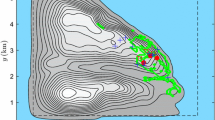Abstract
The note presents a rational approach to modelling the source/sink due to vegetation or buoyancy effects that appear in the turbulent kinetic energy, E, equation and a supplementary equation for a length-scale determining variable, φ, when two-equation closure is applied to canopy and atmospheric boundary-layer flows. The approach implements only standard model coefficients C φ1 and C φ2 in the production and destruction terms of the φ equation, respectively. Numerical tests illustrate the practical applicability of the method, where, for example, simulations with the E–ω model (where \({\varphi=\omega=\varepsilon/E}\) is the specific dissipation and \({\varepsilon}\) is the dissipation rate of E) properly reproduce both the surface-layer wind profile estimated from the Monin-Obukhov similarity theory and the mixing-height evolution observed above forested terrain in Southern Finland.
Similar content being viewed by others
References
Apsley DD, Castro IP (1997) A limited-length-scale k–\({\varepsilon}\) model for the neutral and stably-stratified atmospheric boundary layer. Boundary-Layer Meteorol 83: 75–98. doi:10.1023/A:1000252210512
Ayotte KW, Finnigan JJ, Raupach MR (1999) A second-order closure for neutrally stratified vegetative canopy flows. Boundary-Layer Meteorol 90: 189–216. doi:10.1023/A:1001722609229
Baumert H, Peters H (2000) Second-moment closures and length scales for weakly stratified turbulent shear flows. J Geophys Res 105: 6453–6468. doi:10.1029/1999JC900329
Blackadar AK (1962) The vertical distribution of wind and turbulent exchange in a neutral atmosphere. J Geophys Res 67: 3095–3102. doi:10.1029/JZ067i008p03095
Brunet Y, Finnigan JJ, Raupach MR (1994) A wind tunnel study of air flow in waving wheat: single-point velocity statistics. Boundary-Layer Meteorol 70: 95–132. doi:10.1007/BF00712525
Businger J, Wyngaard JC, Izumi Y, Bradley EF (1971) Flux–profile relationships in the atmospheric surface layer. J Atmos Sci 28: 181–189. doi:10.1175/1520-0469(1971)028<0181:FPRITA>2.0.CO;2
Castro FA, Palma JMLM, Silva Lopes A (2003) Simulation of the Askervein flow: Part 1: Reynolds averaged Navier-Stokes equations (k–\({\varepsilon}\) turbulence model). Boundary-Layer Meteorol 107: 501–530. doi:10.1023/A:1022818327584
Deardorff JW (1972) Numerical investigations of neutral and unstable planetary boundary layers. J Atmos Sci 18: 495–527
Duynkerke PG (1988) Application of the \({E-\varepsilon}\) turbulence closure model to the neutral and stable atmospheric boundary layer. J Atmos Sci 45: 865–880. doi:10.1175/1520-0469(1988)045<0865:AOTTCM>2.0.CO;2
Finnigan JJ (2000) Turbulence in plant canopies. Annu Rev Fluid Mech 32: 519–571. doi:10.1146/annurev.fluid.32.1.519
Finnigan JJ (2007) Turbulent flow in canopies on complex topography and the effects of stable stratification. In: Gayev YA, Hunt JCR (eds) Flow and transport processes with complex obstructions. Springer, Dordrecht, pp 199–219
Finnigan JJ, Shaw RH (2008) Double-averaging methodoly and its application to turbulent flow in and above vegetation canopies. Acta Geophys 56: 534–561. doi:10.2478/s11600-008-0034-x
Hanjalić K (2005) Will RANS survive LES? A view of perspectives. ASME J Fluid Eng 27: 831–839. doi:10.1115/1.2037084
Hanjalić K, Kenjereš S (2008) Some developments in turbulence modeling for wind and environmental engineering. J Wind Eng Ind Aerodyn 96: 1537–1570. doi:10.1016/j.jweia.2008.02.054
Hari P, Kulmala M (2005) Station for measuring ecosystem–atmosphere relations (SMEAR II). Boreal Environ Res 10: 315–322
Hipsey MR, Sivapalan M, Clement TP (2004) A numerical and field investigation of surface heat fluxes from small wind-sheltered waterbodies in semi-arid Western. Environ Fluid Mech 4: 79–106. doi:10.1023/A:1025547707198
Kantha LH (2004) The length scale equation in turbulence models. Nonlinear Process Geophys 11: 83–97.15
Kantha LH, Bao J-W, Carniel S (2005) A note on Tennekes hypothesis and its impact on second moment closure models. Ocean Model 9: 23–29
Katul GG, Mahrt L, Poggi D, Sanz C (2004) One- and two-equation models for canopy turbulence. Boundary- Layer Meteorol 113: 81–109. doi:10.1023/B:BOUN.0000037333.48760.e5
Laakso L, Grönholm T, Kulmala L, Haapanala S, Hirsikko A, Lovejoy ER, Kazil J, Kurtén T, Boy M, Nilsson ED, Sogachev A, Riipinen I, Stratmann F, Kulmala M (2007) Hot-air balloon measurements of vertical variation of boundary layer new particle formation. Boreal Environ Res 12: 279–294
Launder BE, Spalding DB (1974) The numerical computation of turbulent flows. Comput Mech Appl Mech Eng 3: 269–289
Launder BE, Reece GJ, Rodi W (1975) Progress in the development of a Reynolds-stress turbulent closure. J Fluid Mech 68: 537–566. doi:10.1017/S0022112075001814
Moeng C-H (1984) A Large-eddy simulation model for the study of planetary boundary-layer turbulence. J Atmos Sci 41: 2052–2062. doi:10.1175/1520-0469(1984)041<2052:ALESMF>2.0.CO;2
Paulson CA (1970) The mathematical representation of wind speed and temperature profiles in the unstable atmospheric surface layer. J Appl Meteorol 9: 857–860. doi:10.1175/1520-0450(1970)009<0857:TMROWS>2.0.CO;2
Pielke R (2002) Mesoscale meteorological modeling. Academic Press, San Diego, 676pp
Pope SB (2000) Turbulent flows. Cambridge University Press, UK, 771pp
Rao KS, Wyngaard JC, Coté OR (1974) Local advection of momentum, heat, and moisture in micrometeorology. Boundary-Layer Meteorol 7: 331–348. doi:10.1007/BF00240836
Raupach MR, Shaw RH (1982) Averaging procedures for flow within vegetation canopies. Boundary-Layer Meteorol 22: 79–90. doi:10.1007/BF00128057
Seginer I, Mulhearn PJ, Bradley EF, Finnigan JJ (1976) Turbulent flow in a model plant canopy. Boundary-Layer Meteorol 10: 423–453. doi:10.1007/BF00225863
Sogachev A, Panferov O (2006) Modification of two-equation models to account for plant drag. Boundary-Layer Meteorol 121: 229–266. doi:10.1007/s10546-006-9073-5
Sogachev A, Menzhulin G, Heimann M, Lloyd J (2002) A simple three dimensional canopy—planetary boundary layer simulation model for scalar concentrations and fluxes. Tellus 54: 784–819
Svensson U, Häggkvist K (1990) A two-equation turbulence model for canopy flows. J Wind Eng Ind Aerodyn 35: 201–211
Umlauf L, Burchard H (2003) A generic length-scale equation for geophysical turbulence models. J Mar Res 61: 235–265. doi:10.1357/002224003322005087
Wang H, Takle ES (1995) A numerical simulation of boundary-layer flows near shelterbelts. Boundary-Layer Meteorol 75: 141–173. doi:10.1007/BF00721047
Wilcox DC (1988) Reassessment of the scale determining equation for advance turbulence models. AIAA J 26: 1299–1310. doi:10.2514/3.10041
Wilcox DC (2002) Turbulence modeling for CFD. DCW Industries Inc., La Cañada, 540pp
Wilson JD, Finnigan JJ, Raupach MR (1998) A first-order closure for disturbed plant-canopy flows, and its application to winds in a canopy on a ridge. Q J R Meteorol Soc 124: 705–732
Author information
Authors and Affiliations
Corresponding author
Rights and permissions
About this article
Cite this article
Sogachev, A. A Note on Two-Equation Closure Modelling of Canopy Flow. Boundary-Layer Meteorol 130, 423–435 (2009). https://doi.org/10.1007/s10546-008-9346-2
Received:
Accepted:
Published:
Issue Date:
DOI: https://doi.org/10.1007/s10546-008-9346-2




